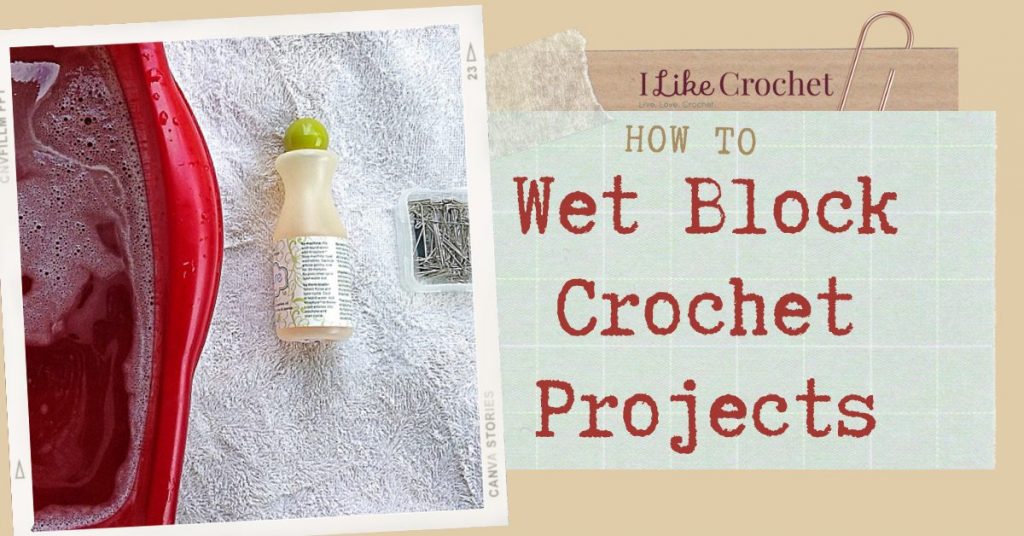
I used to never block my finished crochet projects. I didn’t understand the point of it. I would finish a project and be so excited, and impatient, to wear or send off to its intended recipient. But after many years of crocheting I’ve come to learn the noticeable transformation blocking makes on the final piece. It makes the finished crochet project so much crisper and more professional looking.
While blocking isn’t essential for everything because only natural fibers generally benefit from the full effect of blocking, it is an important part of the finishing process. Blocking, which is wetting the crochet fabric and laying it out flat in order to reshape the fabric, relaxes the stitches, help smooth out lumps and bumps in your stitches, and even out lengths. While it won’t fix most mistakes especially those relating to construction such as missed decreases or increases, blocking helps the yarn to bloom and open up the stitches in a lace project to reveal the lace pattern so the piece goes from looking like cooked spaghetti to a masterpiece. Ready to give it a try on your next project? It’s easier than you think! Just walk through the process in this step-by-step guide.
How To Wet Block Crochet Projects Tutorial
Materials
- Blocking mat or something to block on (if you don’t have blocking mats, you can use can block on your carpet or use your kid’s play mats). This blocking board also works great.
- Pins
- Wool wash (if you don’t have wool wash, use a few drops of gentle shampoo)
- Lukewarm water
- Towel
Instructions
- Fill your sink or basin with lukewarm water and add some wool wash.
- Submerge the crochet piece you want to block into the water. Press out the bubbles without agitating the fabric too much.
- Once your project is thoroughly wet, leave it to soak in the water for 20-30 minutes.
- Remove from the water and gently squeeze out any excess, being careful not to wring the fabric.
- Carefully roll your crochet project into a towel and press to remove excess water.
- Remove your project from the towel, lay it flat and gently shape it with your hands. Use pins as needed to maintain the proper shape. Location of pins will vary from project to project, but below are a few examples of how i’ve used pins to shape my past pieces.
- Leave the piece to finish drying. Do not remove the pins until the project is completely dry.
And that’s all there is to it — you’ve just learned how to block your crochet project and it’s ready to be gifted and enjoyed. If you’ve never tried it before, I really think you’ll be pleased with the results. It makes a big difference, especially with lace stitches where the holes need to be opened up.
Now that you’ve seen the process, tell us:











I have a few wearable crocheted items, which I bought. I have always hand washed them in garment bags and laid them flat to dry.
Itinerary mine to the blocking board (great product. I accidentally found at walmart). I the spray water from a bottle, May do 2 or 3 times. And let dry. Seems to work well.
I’m working on the Crispin Poncho and it states to wet block. I searched how to wet block and came across this article. You make it sound easy enough. I’m willing to give it a go. Looking forward to the end result. Thank you.
I have recently made several small and medium blankets using acrylic yarn. I washed and spun them; then placed them on a blocking board made of 2 sheets of peg board and used wooden dowels as pins. All came out beautifully.
Which yarns do not have to be blocked?
I read that some types of yarn may not have to be blocked. Which yarns are those?
There is no instruction about rinsing the wool wash out of the fabric. Is this done, or is it left on while removing the excess water. Just want to make sure I’m doing this right!
I have never blocked my projects before but I will give it a try next time for sure. Thank you for sharing!
I have always put a piece of cotton fabrics over the crocheted piece and spritz it with water and steam with an iron. It always seems to keep its shape. Then I let it dry.
I have used a steamer to block finished afghans and it works well.
I lay a plastic table cloth over my bed, cover it with large bath towels and hand block my crocheted and knitted garments on the towels. If the are heavier I put them in netted wash bags and spin dry them before I lay them out. I sometimes layout my crocheted table clothes over my fully extended table and hand reshape the motifs while they are still damp.This is after initial blocking of course.
I do a lot of lace doilies and block all of them. Instead of using water only, I add liquid starch. Makes a crispier look. Wouldn’t do this wearable projects
You don’t mention rinsing after soaking in Wool Wash or Gentle Shampoo. Thoughts?
After the items have soaked it soapy water, do they need to be rinsed a bit?
Can I wet block as I finish granny squares before I complete entire work?
Do blocked items have to be blocked after every washing?
Hi Sylvia! Not necessarily to the degree that is done when you first blocked the item, but I would definitely recommend laying the items flat to dry and making sure they are laid out evenly. Hope that helps! – Nicola, Editor
Is there an easier way to block big projects, like afghans? Submerging the whole blanket seems awfully messy.
Take your blankets to a clothes cleaners as they or some will block for you.
I will be using this technique on future projects.
How do i go about doing this on a larger project like a blanket?
You can put your blanket in a bathtub filled with water and a bit of fiber or hair shampoo. Drain the tub, press out excess water and roll up in large towel(s). Put a vinyl tablecloth on an unused bed or floor, shape, pin if necessary, and let dry.
When you wash your wearable crochet pieces in the future, do you need to block again when you dry them?
Hi Cristina! Good question! I would venture to say that most wearable pieces should just be laid flat to dry and to just make sure that it’s laid out evenly. Hope that helps! – Nicola, Editor
I just finished two pocket shawls and a few hats will be blocking for sure. Your instructions are so easy to follow. Thank you.
Very simply explained. .. will be blocking my pieces in future.